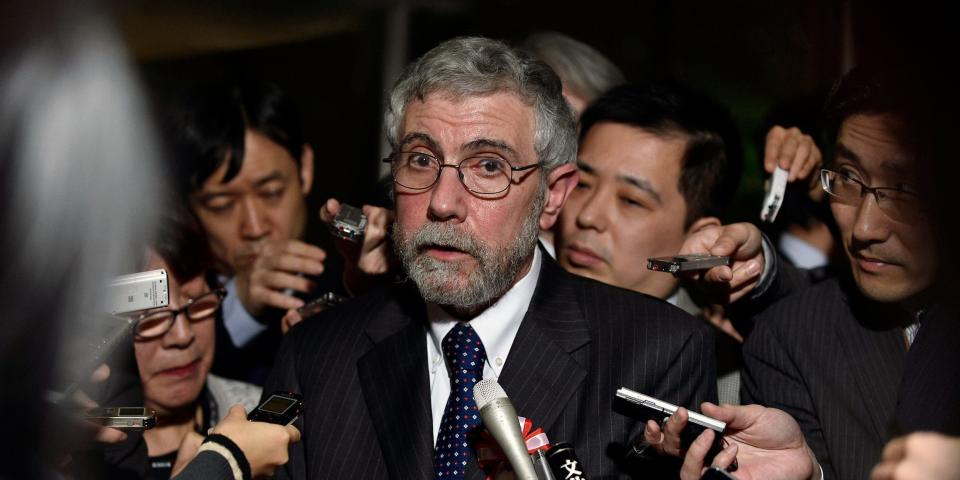Jennifer Sor
·2 min read
The US government doesn't have to pay off its $31 trillion debt, Paul Krugman said.
The government debt can't be compared to something like a household's finances, Krugman said.
"When governments for one reason or another run up large debts, it is, as far as I can tell, unusual to pay those debts off."
The US doesn't actually have to pay off its $31 trillion mountain of debt, according to top economist Paul Krugman, hitting back at the idea that government finances can be compared to household balance sheets in an op-ed weeks before the US possibly defaults on some obligations.
Though individual borrowers are expected to pay off debts, the same isn't true for governments, Krugman argued in a column for the New York Times on Friday. That's because unlike people, governments don't die, and they gain more revenue with each passing generation.
"Governments, then, must service their debts – pay interest and repay principal when bonds come due – but they don't necessarily have to pay them off; they can issue new bonds to pay principal on old bonds and even borrow to pay interest as long as overall debt doesn't rise too much faster than revenue," he added.
Though the debt-to-GDP ratio hovered around 97% last year, interest payments on that debt is only around $395 billion, according to the Office of Management and Budget, or around 1% of last year's GDP.
Historically, it's also unusual for governments to pay off large debts, Krugman said. Such was the case for Great Britain, which has largely held onto the debt it incurred as far back as the Napoleonic wars.
Krugman's argument comes amid growing contention over the US debt level, with policymakers still sparring over the conditions they want to raise the country's borrowing limit. House Speaker Kevin McCarthy has said he would reject a short-term debt ceiling increase unless spending cuts are negotiated, having proposed a bill that would slash around $4.5 trillion on spending.
Congress now has less than two weeks to raise the borrowing limit before the government could potentially run out of cash, US Treasury Secretary Janet Yellen warned. A default on the country's obligations could result incatastrophe for financial markets, experts have warned. Krugman has called for the debt ceiling to be abolished, as the risk of a financial crisis offers Republicans a "choke point" on fiscal policy.
Read the original article on Business Insider
This discussion dives deep into economic theory, debt dynamics, government financing, and the current political landscape in the United States. As someone who's extensively delved into these topics, let's break down the concepts involved:
-
Government Debt and Household Finances: Paul Krugman's argument emphasizes a fundamental difference between government and household debt. Governments have a distinct capacity to manage debt due to their perpetual existence and ability to generate revenue across generations. Unlike individuals, governments aren't expected to entirely pay off debts; rather, they service them by paying interest and repaying principal when bonds mature.
-
Debt Servicing vs. Paying Off Debt: Krugman highlights that governments can manage their debts by issuing new bonds to cover old ones, ensuring the debt doesn't grow substantially faster than their revenue. This approach allows for the servicing of debt without the necessity of outright repayment.
-
Historical Perspective: The article also draws historical parallels, citing instances like Great Britain's retention of debt from past wars, indicating that it's atypical for governments to completely eliminate large debts.
-
Debt-to-GDP Ratio and Interest Payments: Despite the high debt-to-GDP ratio (97%), the interest payments on the debt are relatively low, standing at around $395 billion, approximately 1% of last year's GDP. This implies that while the debt is substantial, the interest burden remains manageable within the broader economic context.
-
Current Political Debate and Fiscal Policy: The article touches upon the ongoing political debate regarding the US debt ceiling. There's a looming deadline for raising the borrowing limit, with discussions revolving around spending cuts and the risk of a potential default. Janet Yellen has warned of catastrophic consequences in financial markets if the borrowing limit isn't raised in time.
-
Calls for Policy Change: Krugman advocates for the abolition of the debt ceiling, arguing that its existence creates a risky "choke point" in fiscal policy, particularly in the hands of opposing political parties.
Understanding these concepts requires familiarity with economics, fiscal policy, historical precedents, and the intricacies of government debt management. Krugman's stance emphasizes the nuanced nature of sovereign debt and its divergence from personal financial obligations, shedding light on the complex dynamics governing national economies.
